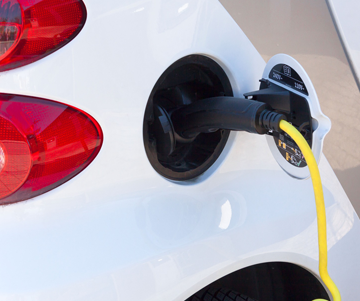Electric Vehicles: A Smart Choice in Alameda
Cost Less to Own and Operate
Driving an electric vehicle (or EV) can be three to five times cheaper than driving conventional gasoline- and diesel-powered cars, depending on your local gasoline and electric rates. Electricity is less expensive than gasoline and EVs are more efficient than gasoline-powered vehicles. Electric prices are also generally much more stable than gasoline prices.
Also, battery electric vehicles (or BEVs) require less maintenance than conventional vehicles because there are fewer fluids (like oil and transmission fluid) to change, and far fewer moving parts. EVs require minimal scheduled maintenance to their electrical systems, which can include the battery, electrical motor, and associated electronics. Because of regenerative braking, brake systems on EVs typically last longer than on conventional vehicles.
Environmentally Friendly
Transportation contributes nearly 40 percent of all greenhouse gas (GHG) emissions in California – more than any other economic sector. The stakes are even higher in Alameda, where transportation emissions make up half of all GHG emissions. The good news is that EVs have no tailpipe emissions. Plus, Alameda Municipal Power (AMP) provides you with 100% clean energy, which means that you’re filling up your EV with emissions-free electricity.
Never Go to the Gas Station Again
Electric vehicles do not require gasoline and can be charged at home with a standard 120V outlet. A 240V level 2 charger can be installed at home for faster, more efficient charging.
EV Performance Benefits
Electric motors provide quiet, smooth operation, have better acceleration and handling, and have no background hum or vibration, making your ride more relaxing.
EV Driving Range and Recharge Time
The driving range of most EVs is between 80 and 300 miles on a full charge. The average American’s daily round-trip commute is less than 30 miles. Fully recharging the battery pack can take four to eight hours, which is easy to do while you’re at work or asleep. A "fast charge" to 80% capacity can take as little as 20-30 minutes at a public charging station, according to the U.S. Department of Energy.
Driving an electric vehicle (or EV) can be three to five times cheaper than driving conventional gasoline- and diesel-powered cars, depending on your local gasoline and electric rates. Electricity is less expensive than gasoline and EVs are more efficient than gasoline-powered vehicles. Electric prices are also generally much more stable than gasoline prices.
Also, battery electric vehicles (or BEVs) require less maintenance than conventional vehicles because there are fewer fluids (like oil and transmission fluid) to change, and far fewer moving parts. EVs require minimal scheduled maintenance to their electrical systems, which can include the battery, electrical motor, and associated electronics. Because of regenerative braking, brake systems on EVs typically last longer than on conventional vehicles.
Environmentally Friendly
Transportation contributes nearly 40 percent of all greenhouse gas (GHG) emissions in California – more than any other economic sector. The stakes are even higher in Alameda, where transportation emissions make up half of all GHG emissions. The good news is that EVs have no tailpipe emissions. Plus, Alameda Municipal Power (AMP) provides you with 100% clean energy, which means that you’re filling up your EV with emissions-free electricity.
Never Go to the Gas Station Again
Electric vehicles do not require gasoline and can be charged at home with a standard 120V outlet. A 240V level 2 charger can be installed at home for faster, more efficient charging.
EV Performance Benefits
Electric motors provide quiet, smooth operation, have better acceleration and handling, and have no background hum or vibration, making your ride more relaxing.
EV Driving Range and Recharge Time
The driving range of most EVs is between 80 and 300 miles on a full charge. The average American’s daily round-trip commute is less than 30 miles. Fully recharging the battery pack can take four to eight hours, which is easy to do while you’re at work or asleep. A "fast charge" to 80% capacity can take as little as 20-30 minutes at a public charging station, according to the U.S. Department of Energy.


